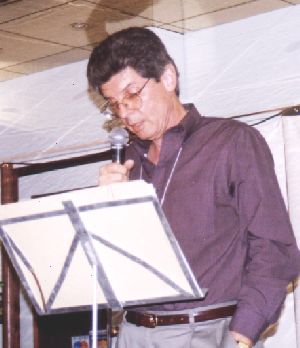 Prof.
Paul Toews of Pacific University in Fresno, delivered a pair of outstanding lectures on
the history of Mennonites in the region. Prof.
Paul Toews of Pacific University in Fresno, delivered a pair of outstanding lectures on
the history of Mennonites in the region.The first was on the period from the 1770s,
when the Mennonites first came to South Russia, until 1914, when life was disrupted
forever by WWI followed by the revolution. Although most of the facts of Mennonite
life during this period were familiar, Paul did a masterful job of tying them together:
What did they hope to accomplish as a religious community in coming to South Russia
and what actually happened? How they handled problems:
- Civil authority compared with traditional religious authority.
- A class of people without land within their own society.
- Factionalism in the religious community (represented in our family through the Kleine
Gemeinde and the Mennonite Brethren.)
- The effects of the reforms of Alexander II.
There was a "golden age" for Mennonites from the late 19th century through
1914 when Mennonites in Russia were intellectually and culturally far advanced compared
with Mennonites in North America or anywhere else. He spoke of their impact.
Although this was not part of our Mennonite story, at least not directly, I found it very
helpful; it would prove of great importance as we continued.
After the first lecture, there was time for Faspa, complete with traditional
Mennonite crullers along with watermelon and coffee. We sat with Agnes and John
Klassen of British Colombia, both of whom were born in Molotschna and, as children, made
the terrifying trip to Germany with the retreating armies; there, like 30,000 other
Mennonites, they were slated to be sent back, but they were part of the minority who
managed to escape that fate and were sponsored by Canadians.
Agnes was most eager to talk about it. I commented that I had read about it, to
which she responded, "but you didn't live it." Like many men of his
period, John was much less eager to talk about the experience. Traveling with people
who told us of such life experiences turned out to be one of the greatest unexpected
blessings.
The second lecture that afternoon continued with the repeated waves of terror,
starvation, and persecution that were visited on Mennonites until the last of them left at
the end of WWII. This was the story of fellow passengers or their parents or
grandparents.
In the evening, Rudy Friesen present his specialty, the architecture of the Mennonite
colonies. He reached back to the time when our families were still there, but
obviously most examples were of late 19th century and 20th century houses, schools, and
churches. Again there was more to be learned than I could easily assimilate in an
hour. I wonder and only partly understand who the influences were as patterns
developed. Johann Cornies and, later, people studying in Germany had great effect.
Later, we would have an additional lecture by Paul on Mennonites in Crimea. Our Warkentin
family came to America from there in 1874. |